Kreg Jig vs Biscuit Joiner: Differences of Pocket Holes and Biscuit Joints
What are the differences between a Kreg Jig and biscuit joiner? Which is easier, faster, and creates a stronger joint? Which is best for your DIY projects?
Recently I received a question from Kathy asking me to compare and contrast a Kreg Jig vs a biscuit joiner. This a question I can really get into. I have years of experience working with both a biscuit joiner and a Kreg Jig.
For your convenience, this post contains affiliate links to supplies or tools I used to complete this project. Purchases made using these links help support the Saws on Skates website and allow me to share more DIY projects. and DIY tips with you. There is no cost to you for using these links. Click here to visit my site policies.
For the longest time, I built my DIY projects with a biscuit joiner. Before I started Saws on Skates I built reproduction wood window screens and screen doors using my biscuit joiner for a 1800s apartment building. Those window screens were very similar to the window screens I built for my own house and the screen doors were similar to the screen door I built for my friend Linda’s home.
Later on, I attended a woodworking show where I saw a demonstration of the Kreg Jig and I had to have one. Since then I’ve built quite a few furniture projects using pocket holes. Now I have both a Kreg Jig and biscuit joiner in my tool arsenal.
Kreg Jig vs Biscuit Joiner Question
Before I share Kathy’s question with you I want to let you know something. Kathy included a brand of biscuit joiner in her message to me. I removed the reference to the brand from her question below because I want the focus of this post to compare pocket hole joinery vs biscuit joinery rather than one brand vs another brand.
I just signed up for your newsletter when I found your site by chance. I have no experience with power tools or woodworking, but we bought a cabin in the mountains and wondered if it would be fun to make some simple furnishings. My question is regarding the Kreg pocket hole joints vs a biscuit joiner. Can you give me some pros vs cons [of] using one over the other? We already own [a biscuit joiner]. Thanks! Kathy”
First, thank you for signing up to receive the weekly newsletter, Kathy! If you’re like Kathy and want to be notified when a new post is published skate to the bottom of this page and enter your first name and email address.
The quick answer to Kathy’s question is for most projects you should be able to use biscuit joinery in place of pocket hole joinery, but there are some important differences and considerations between the two types of joinery you should be aware of. Let’s look at how a Kreg Jig works, how a biscuit joiner works, which is faster, which is easier to use and which type of joinery I prefer for my DIY projects.
What is a Kreg Jig?
A Kreg Jig or pocket hole jig uses a guide block with preset holes to drill angled pocket holes in a workpiece. A pocket screw, specifically designed to be used with pocket holes draws the two workpieces together to form a strong joint.
Since we’re talking about pocket hole joints I think you’ll enjoy these tutorials:
- How to Join Different-Sized Boards with Pocket Holes
- Need to Know Pocket Hole Tips for Edge Joints
- Drilling Pocket Holes on Miter Joints Requires Careful Planning
Types of Kreg Jigs
There are five common types of pocket hole jigs you’ll often see. Those are the Kreg Jig Mini, Kreg Jig R3, Kreg Jig K4, Kreg Jig K5, and the Kreg Foreman.
Kreg Jig Mini
The Kreg Jig Mini is great for making hard-to-reach repairs. For set up tips and repair ideas skate over to my Kreg Jig Mini Makes Hard-to-Reach Repairs Easy post
Kreg Jig R3
The Kreg Jig R3 is great for repairs and building small furniture projects.
Kreg Jig K4
The Kreg Jig K4 is great for building furniture projects of all sizes.
Kreg Jig K5
The Kreg Jig K5 is great for building furniture projects of all sizes and features a ratcheting clamp. Skate over to 5 Reasons Why the Kreg Jig K5 Will Change the Way You Make Pocket Holes to see more unique features.
Kreg Foreman
The Kreg Foreman is great for the serious builder who needs to drill lots of pocket holes quickly.

What is a Biscuit Joiner?
A biscuit joiner or plate joiner has a small horizontally mounted saw blade. When the biscuit joiner is pushed into a workpiece the blade cuts a half-moon shaped slot. Then the biscuit joiner is positioned on the corresponding workpiece and the blade is pushed into the workpiece which cuts the second half of the slot.
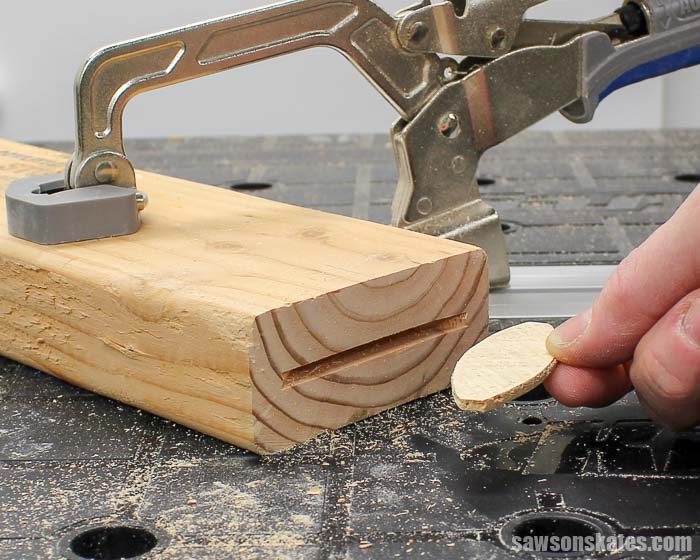
Glue is applied to a thin football shaped wafer called a biscuit. The biscuit is placed into the slots and the joint is clamped until the glue dries.
A biscuit joiner can cut three sizes of slots. The smallest biscuit is “0”, the medium size biscuit is “10” and “20” is the largest biscuit. The “0” and “10” biscuits might be used for smaller joints like joining a rail to a stile. A “20” biscuit might be used for edge joints to join boards to form a table top.
Popular Biscuit Joiners
DeWALT Plate Joiner
Porter-Cable Plate Joiner
What are the Differences Between a Kreg Jig vs Biscuit Joiner?
Great Alignment
In my opinion, the best feature of a biscuit joiner is the way it can precisely align joints. The slots and biscuits do a great job of keeping the faces of the workpieces flush when you’re assembling your project.
I wouldn’t say alignment is a con when using a Kreg Jig, but it’s something to be aware of when assembling your project. With pocket hole joinery there isn’t anything to keep the faces of the workpieces flush. Flush fitting joints rely completely on tightly clamping your project.
Special pocket hole clamps and face clamps are available, but I typically use an assortment of bar clamps and scrap wood as cauls for tightly clamping my pocket hole projects.
Easy Joint Locations
The Kreg Jig allows much more flexibility with the joint location because you only need to drill pocket holes on one side of the joint. With a biscuit joiner, you need to cut a biscuit slot on both sides of the joint and this could get a little tricky with some joints.
Let’s say you wanted to build a cleat to hold up some floating shelves. If you used a Kreg Jig you would drill pocket holes on the ends of the short cleats, clamp to the long cleat and drive some pocket hole screws.
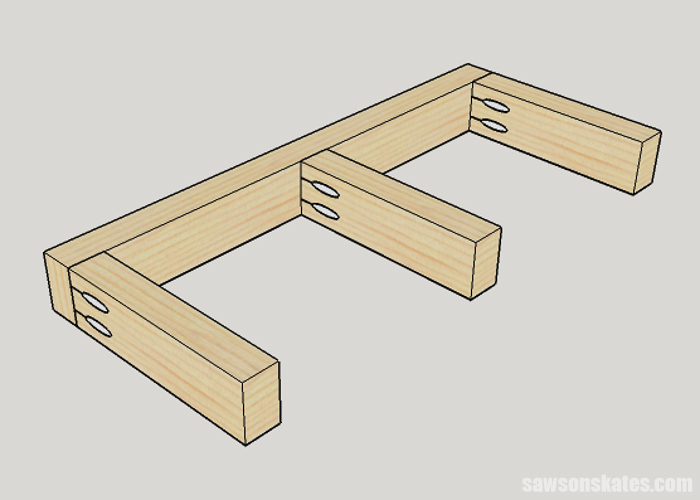
If you used a biscuit joiner you would first cut biscuit slots on the ends of the short cleats. That’s the easy part. We can place the cleats on our workbench, clamp them to the bench, plunge the biscuit joiner into the workpiece and cut the biscuit slot.
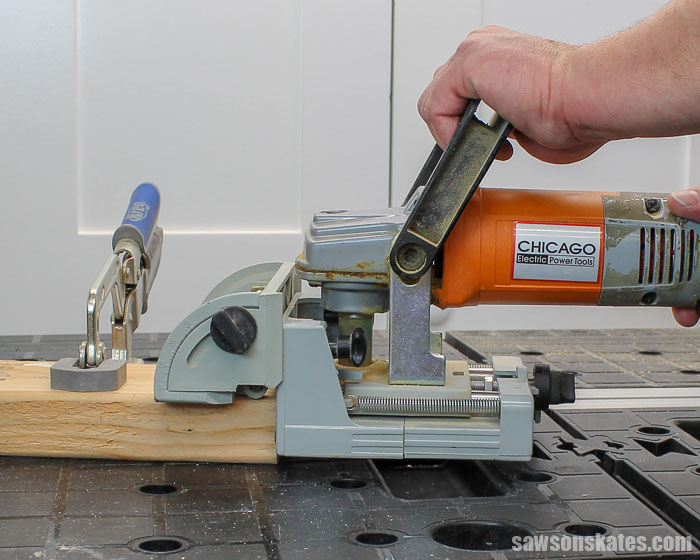
Next comes the tricky part of cutting biscuit slots on the long cleat. The biscuit slots need to be cut in the face of the long cleat which requires a slightly different approach. We can’t just place the long cleat on our workbench and cut the slot because the guard would prevent the biscuit joiner from reaching our workpiece. Removing the guard could cause the slot to be misaligned which means it might not match up to the slot in the short cleat.
We can’t hold the cleat and cut the biscuit slot because that would be dangerous. So how do we do it? We would need to place the cleat so it hangs off the edge of our workbench, clamp the workpiece to the bench and cut the slot.
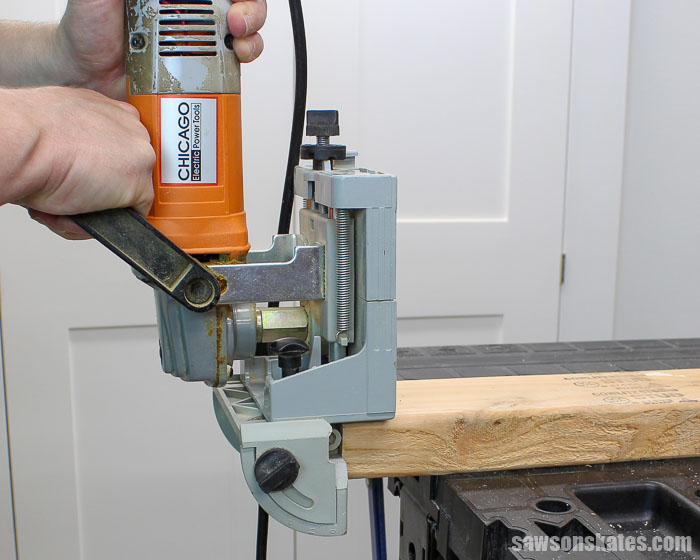
The trouble is it’s a little awkward to hold the biscuit joiner in this position and keep it totally vertical when pushing the joiner to cut the slot. In other words, the slot might accidentally be cut at an angle. This could cause the slot in the short cleat not to properly line up with the slot in the long cleat making for a poor fitting joint.
Which is Stronger?
Before I answer the question about whether a pocket hole joint or a biscuit joint is stronger I need to first say I’m not an engineer. I don’t have a method to test the strength of the two joints so this is my personal opinion.
I have used both pocket hole joints and biscuit joints when building my DIY furniture projects and my observation is the joints are equally strong. I don’t recall a time when properly used that a pocket hole joint or a biscuit joint came loose or broke.
I’ve heard of a technique where biscuit joinery and pocket hole joinery are used for the same joint. First, biscuit slots are cut, glue is applied to the biscuit, inserted in the slots and the joint is clamped. Then pocket holes are drilled through the joint and pocket hole screws are attached.
I have never tried this technique, but it seems like it would create a doubly strong joint. But like I mentioned, I don’t recall ever having a pocket hole joint or biscuit joint break.
Which is Faster?
With the biscuit joiner, you need to cut two biscuit slots one on each side of the joint. Next glue is applied to the biscuit, the biscuit is inserted in the slots and the joint is clamped. Then you have to wait for the glue to dry. This means there’s lots of downtime before you can move on to the next step of your project. I don’t know about you but I’m impatient and I hate waiting!
With a Kreg Jig, you can drill the pocket holes, apply glue, clamp the joint, and drive the pocket screws… DONE! You’re ready to move on to the next step of your project.
Using pocket hole joinery might allow you to build a project on a weekend versus a week or two when building with a biscuit joiner. For me, the Kreg Jig has a biscuit joiner beat on speed.
Which is Easier to Use?
When thinking about if a Kreg Jig vs a biscuit joiner is easier to use I look back to our cleat example. In that example, we drilled some pocket holes with a Kreg Jig and assembled the cleat.
To make the same cleat assembly with a biscuit joiner we first cut biscuit slots in the short cleats. Then we had to reposition to cut slots in the face of the long cleat and then assemble the cleats.
In my opinion, a pocket hole joint is easier to use than a biscuit joint.
Which do I Prefer?
So that’s an overview of the Kreg Jig and a biscuit joiner. By now you probably already have a guess which joinery method I prefer. Because of the flexibility of the joint location, because it’s faster and because it’s easier to use I prefer pocket hole joinery.
Please don’t take this the wrong way. I’m not knocking biscuit joinery. I still use my biscuit joiner from time to time, but hands down nearly all of my projects are built with my Kreg Jig.
Final Thoughts
There are some unique differences between a Kreg Jig and biscuit joiner. A biscuit joiner does a great job of properly aligning the faces of workpieces, but in my opinion, a Kreg Jig is faster, easier to use and my preferred joinery method for building my DIY projects.
Thank you for stopping by. If you found this information helpful, would you please pin it to Pinterest? Other DIYers would appreciate it and I would too! Thank you – Scott

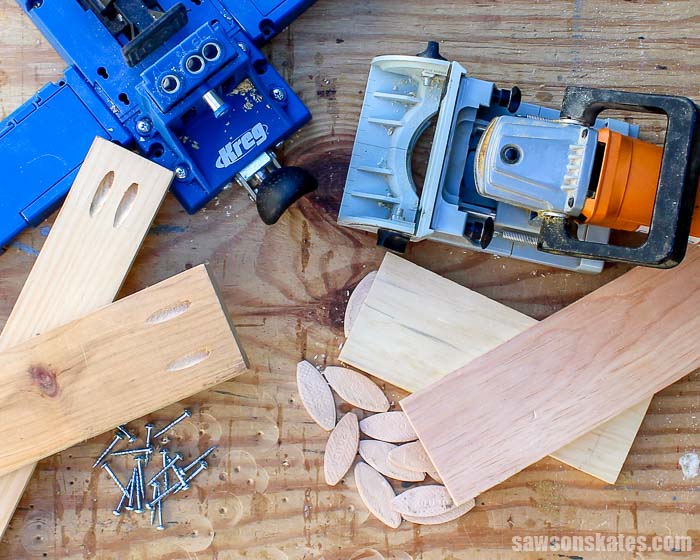






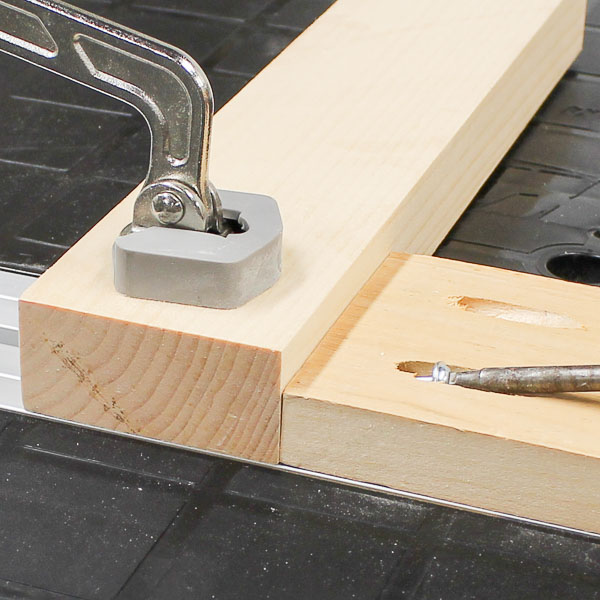
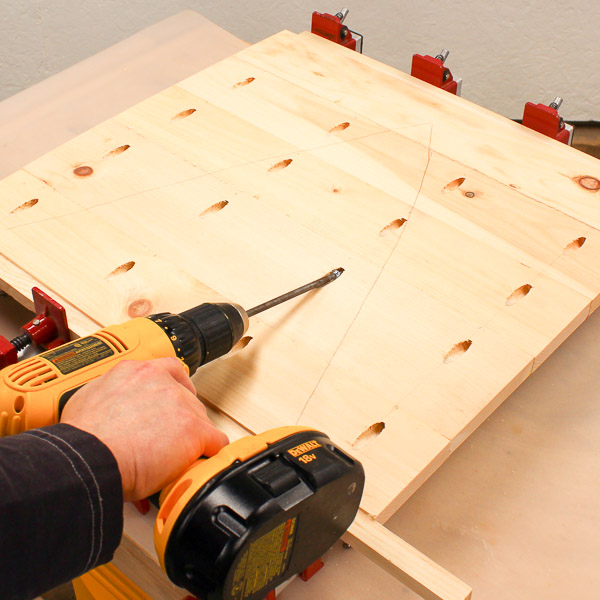
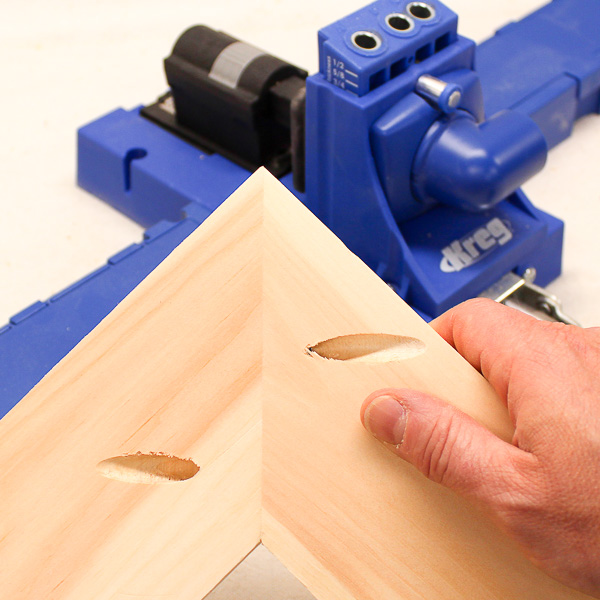

You forgot too ask “which one looks better?”. Biscuits win on that one hands down. They are invisible from the start. To hide a kreg joint, you have to glue in a plug, sand it, add wood filler, wait again and sand again. And it’s still visible unless you spend even more time making the plug from scratch.
I love my kreg jig because I tend to err on the side of speed and practicality, but man are those joints ugly.
Hi Ben – Thank you for stopping by. That’s a great point and I totally overlooked it. You’re right, biscuit joints are invisible.
Awesome review Scott! As always, you are clear and detailed. This has been so helpful! Keep up the great work and I look forward to your reviews!
Hi Tracey – Thank you so much for the kind words! I’m glad you found it helpful.
Another advantage to the bisquit joinery is there is no tell-tail hole to fill and sand. And even then they show unless your paint the item
Hi Mark – Thank you for stopping by. That’s a great point biscuit joints are totally invisible.
Great post, Scott! I love my Kreg Jig. I’ve never used a biscuit joiner but I do have one thought that people may want to consider. If your joint will be seen from both sides, the biscuit joiner might provide a cleaner look. While there are options out there for filling pocket holes, they’re not perfect and may not look as neat – especially if you’re staining the final project. Just something to think about…
Thanks for all you do!
Hi Melissa – Thank you for stopping by and for the compliments! You’re right, that’s an excellent point that I overlooked in the post. Biscuit joints are completely invisible compared to pocket holes.
Very well explained, easy to understand. Thank you
Hi Roland – Thank you for stopping by and for the compliments. I appreciate it!
Excellent Post, very well explained. I love my Kreg Jig but I’m going to buy a joiner just to tried it. As you comment to Mellisa earlier the bicuit joints are invisible that a good point.
Hand shake from Puerto Rico.
Hi Luis – Thank you for stopping by and for the compliments!
Good advise all around. One thing I would add is that Kreg holes can leave some VERY sharp splinters depending on species of wood, and kids crawling around inside base cabinetry is a given. I I speak from experience, hide those joints if you can.
Hi Steve – That’s a good tip. Thank you for sharing.
Thanks so much for your analysis! I’ve been using your blog for help building a massive table and it’s been really helpful. Would you say that a biscuit is better for a table top since it could allow the able to shift slightly as the board swell, or would that make it a worse option? I was planning on doing pocket holes and glue, but after reading your tips for preventing cracking, I’m hesitant to do that. This is my first large project with hardwoods, so I’m trying to identify all the best ways to do each part.
Hi Tristan – Thank you for stopping by. Using either pocket holes or biscuits is a good way to edge join a tabletop. But we don’t want to attach a tabletop to the sides or aprons of a table with pocket holes. This would prevent the top from moving due to seasonal changes. The best way to attach a tabletop is with tabletop fasteners. Check out this post for more info.